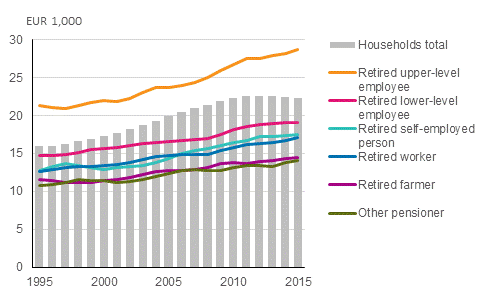Published: 24 March 2017
Pensioner households have big income differential
According to Statistics Finland's income distribution statistics, there were good 890,000 pensioner households in Finland, which is as many as one-third of all households in the country. Pensioner households whose reference person had been an upper-level employee when working have clearly the highest income. Their income level was distinctly higher than for total households. The income level was weakest in those pensioner households where the reference person had not been in working life when active. The income level of this group is clearly below the general income level of households.
Pensioner households’ income according to the reference person’s previous socio-economic group, EUR in 2005 money

Three-year moving average. Income concept equivalent disposable monetary income per household. Equivalent income is the household's disposable income divided by the number of consumption units in the household. The household reference person is as a rule the member of the household with the highest income.
The median for households’ equivalent disposable monetary income was EUR 22,300 in 2015. For pensioner households, the corresponding income was EUR 18,700. Inside pensioner households the distribution of income was great, however. Pensioner households whose reference person was a former upper-level employee had clearly the highest income. In these pensioner households the median income was EUR 29,000. The number of pensioner households with retired upper-level employees was in 2015 nearly 130,000, that is, around 14 per cent of all pensioner households.
Among pensioner households, households where the reference person is other than an earnings-related pension recipient (other pensioner) had the lowest income. The median income of these persons living primarily on national pension was EUR 14,000. The median income of retired farmer households was also fairly low, being EUR 15,000 in 2015. Both of these low-income pensioner groups are fairly small; other pensioner households numbered around 25,000 and retired farmer households good 60,000 in 2015.
Households of retired workers is the biggest group of pensioner households, around 320,000 in 2015. This made up 36 per cent of all pensioner households. The equivalent median income of this group was EUR 17,500. The next biggest pensioner group constituted households of retired lower-level employees, being 290,000. They accounted for 32 per cent of all pensioner households. The median income of retired lower-level employee households was about EUR 19,200 in 2015.
There were nearly 70,000 retired self-employed households in 2015. The median for equivalent disposable monetary income of this pensioner group was EUR 17,900.
The examinations above were made with the median for equivalent disposable monetary income. The income concept is internationally comparable and it does not include imputed income items (such as income from owner-occupied dwellings) or sales profits. Comparison by households' population groups with different income concepts is possible with the help of income distribution statistics’ database tables.
Source: Income Distribution Statistics 2015, Statistics Finland
Inquiries: Pekka Ruotsalainen 029 551 2610
Director in charge: Jari Tarkoma
- Tables
-
Tables in databases
Pick the data you need into tables, view the data as graphs, or download the data for your use.
Updated 24.03.2017
Official Statistics of Finland (OSF):
Income distribution statistics [e-publication].
ISSN=1799-1331. Income differentials between population subgroups 2015. Helsinki: Statistics Finland [referred: 17.12.2025].
Access method: http://stat.fi/til/tjt/2015/02/tjt_2015_02_2017-03-24_tie_001_en.html

